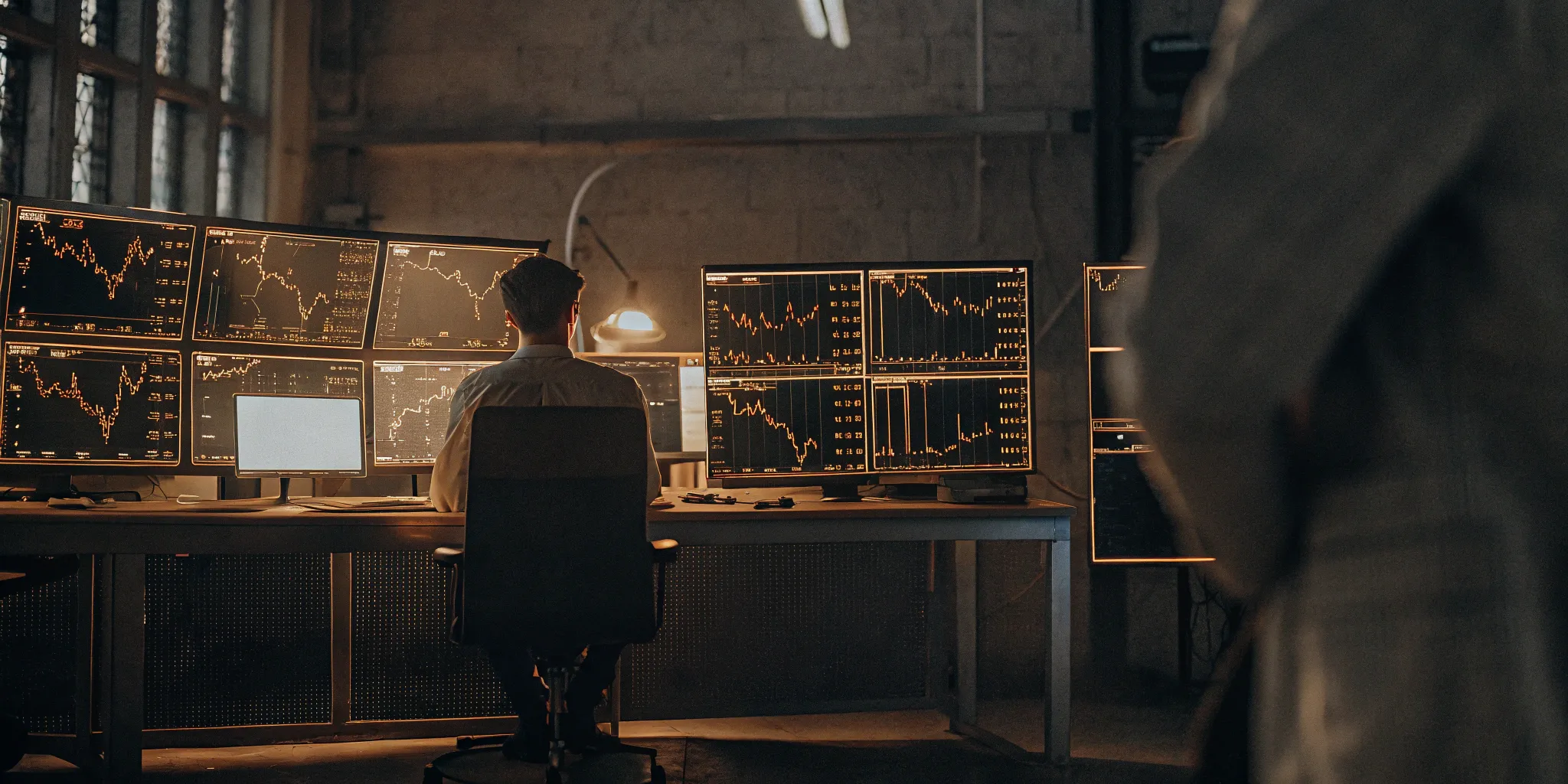Tired of second-guessing your trades? Algorithmic trading offers a data-driven approach, removing emotional biases and executing trades with lightning-fast speed. But is it a guaranteed path to riches? Not quite. This comprehensive guide explores the world of algo trading, providing a balanced perspective on the algo trading platform pros and cons. We’ll delve into the key components of successful algo trading systems, discuss the essential skills you’ll need, and address common misconceptions. By the end of this post, you’ll have a clearer understanding of what algo trading entails and whether it aligns with your trading goals and resources.
Key Takeaways
- Automated trading offers speed and efficiency, but requires ongoing oversight: Remove emotional biases and capitalize on market opportunities faster than manual trading allows. However, remember that thorough testing and continuous monitoring are essential for long-term success.
- Balance automation with risk management: System failures, over-optimization, and liquidity challenges are inherent risks. Human oversight is crucial for navigating these complexities and adapting to unexpected market events.
- Algo trading is accessible, but requires a realistic approach: User-friendly platforms and tools make it easier to get started, even without advanced programming skills. Begin with a simple, well-defined strategy, backtest thoroughly, and gradually transition from manual trading to build confidence and experience.
What is Algorithmic Trading?
Algorithmic trading uses computer programs to automatically buy and sell securities based on pre-defined rules (algorithms). It’s different from discretionary trading, where humans make all the decisions. Think of it as setting your trading strategy on autopilot. You establish the parameters, and the computer executes trades according to your plan, free from emotional impulses or hesitation. This automated approach can range from simple instructions, like buying a certain stock when it dips below a specific price, to complex strategies involving multiple indicators and market conditions. Algo trading offers a systematic way to approach the markets, removing human bias from the equation.
How Algo Trading Platforms Work
Algorithmic trading platforms leverage advanced mathematical models to make transaction decisions. These platforms execute trades far faster than any human could manage, meticulously following pre-set rules and analyzing a vast array of market data, including price, volume, and timing. Imagine trying to monitor every fluctuation in a stock’s price and react instantly – it’s simply not feasible. Algo trading platforms, however, excel at this, processing information and executing trades in milliseconds. This speed and precision are crucial in today’s fast-moving markets.
Key Components of Algo Trading Systems
Effective algo trading systems rely on a few core components. First, they need robust backtesting capabilities, allowing you to test your algorithms using historical data. This helps refine your strategies and ensures they can handle various market scenarios. Second, access to real-time market data is essential. Your system needs up-to-the-second information to make informed decisions. A good algo trading platform will provide this. Finally, customization options are key. Your platform should allow you to tailor your algorithms to your specific trading style and risk tolerance. And, of course, risk management is paramount. No system is foolproof, so having safeguards in place to protect your capital is crucial.
Advantages of Algorithmic Trading Platforms
Algorithmic trading platforms offer several compelling advantages, especially for those looking to systematize their approach and potentially improve their trading outcomes. Let’s explore some key benefits:
Execute Trades Quickly and Efficiently
Speed is critical in trading, and algorithmic systems excel here. Automated trading platforms execute trades far faster than any human, allowing you to capitalize on fleeting opportunities that might only last milliseconds. This speed advantage can be especially crucial in volatile markets, where prices can change dramatically in short periods. A well-designed algorithm can react instantly to market changes, potentially securing better prices and increasing profitability. This rapid execution also helps minimize slippage—the difference between the expected price of a trade and the price at which it’s executed. Investopedia offers a comprehensive look at how algorithmic trading works.
Make Emotionless Decisions
One of the biggest trading challenges is managing emotions. Fear, greed, and hope can cloud judgment and lead to impulsive decisions. Algorithmic trading removes these emotional biases. By following predefined rules, algorithms execute trades based on logic and data, not gut feelings. This disciplined approach can lead to more consistent and rational trading outcomes, helping you stick to your strategy even when market conditions get turbulent. This doesn’t mean you won’t feel the emotional ups and downs of trading, but it does mean your decisions will be data-driven.
Backtest and Optimize Strategies
Before risking real capital, test your trading strategies. Algorithmic trading platforms let you backtest your strategies on historical data, simulating how they would have performed in past market conditions. This helps you identify potential flaws and refine your approach before going live. Backtesting provides valuable insights into your strategy’s potential profitability and risk profile, allowing you to make data-driven adjustments and optimize for better performance. Think of it as a dress rehearsal for your trading plan, giving you a chance to iron out any wrinkles.
Manage and Control Risk
Effective risk management is crucial for long-term trading success. Algo trading platforms offer advanced risk management tools that go beyond manual trading capabilities. These tools include real-time portfolio monitoring, diversification across different assets, and adaptive risk controls that adjust to changing market conditions. Automated stops and limits help you define your maximum acceptable loss and profit targets for each trade, protecting your capital from unexpected market swings. For a helpful comparison of algo trading versus manual trading, check out this article from uTrade Algos highlighting the risk management advantages of automated systems.
Potential Drawbacks of Algo Trading Platforms
While algorithmic trading offers numerous advantages, it’s essential to understand the potential downsides before diving in. Like any investment strategy, algo trading has inherent risks that require careful consideration.
Understand System Failures and Technical Risks
Technical glitches are a real concern with algo trading platforms. A software bug, a faulty internet connection, or a power outage can disrupt your automated trades, potentially leading to significant losses. These risks are amplified by the speed and volume of trades executed by algorithms. A small error can quickly snowball into a substantial problem if left unchecked. Robust risk management protocols and system redundancies are crucial to mitigate these risks.
Avoid Over-Optimization Pitfalls
One of the biggest pitfalls in algo trading is over-optimization. It’s tempting to create an algorithm that performs flawlessly on historical data. However, an over-optimized algorithm might be too finely tuned to past market conditions and fail to adapt to real-time market dynamics. This phenomenon, known as “overfitting,” can lead to disappointing results when your strategy encounters new market scenarios. Finding the right balance between optimization and adaptability is key to long-term success in algo trading. Experts often advise focusing on broader market trends and avoiding strategies that are excessively tailored to historical data.
Recognize Liquidity Challenges
Algorithmic trading can sometimes exacerbate liquidity issues, particularly during periods of market volatility. If multiple algorithms react similarly to a sudden market event, it can create a cascade effect, worsening instability and potentially causing flash crashes. Understanding how your algorithms interact with market liquidity is crucial for responsible algo trading.
Consider Regulatory and Compliance Issues
The regulatory landscape for algo trading is constantly evolving. Regulations can change, impacting how you implement and manage your algo trading strategies. Staying informed about current rules and anticipating future changes is essential for maintaining compliance and avoiding penalties. Failing to adapt to regulatory updates can limit your trading options and expose you to unnecessary risks.
Essential Skills for Successful Algo Trading
So, you’re intrigued by algo trading and ready to explore this fascinating world? Great! Before you dive in, it’s helpful to understand the essential skills that can set you up for success. Think of these as your building blocks for navigating the complexities of automated trading.
Learn Programming and Financial Markets
A foundational understanding of programming is key. Languages like Python, C++, and Java are commonly used in algo trading because you’ll need to write the code that executes your trading strategies. You don’t need to become a coding whiz overnight, but familiarizing yourself with the basics is a must. Alongside programming, a solid grasp of financial markets is crucial. You need to understand how markets behave, the factors that influence price movements, and the various instruments you can trade.
Analyze Data and Understand Statistics
Data is the lifeblood of algo trading. Your algorithms will analyze vast amounts of data to identify patterns and make trading decisions. This means you need to be comfortable working with data and have a basic understanding of statistical concepts. You’ll need to interpret data, identify trends, and evaluate the performance of your algorithms. Effective risk management is also essential, requiring a proactive approach to portfolio diversification and risk mitigation.
Learn and Adapt Continuously
The world of algo trading is constantly evolving. New technologies emerge, market conditions change, and algorithms need continuous improvement to stay competitive. A willingness to learn and adapt is essential for long-term success. Stay curious, explore new ideas, and be prepared to refine your strategies as needed. Articles like this one from Share India offer insights into the dynamic nature of algo trading and the importance of continuous learning. Remember, successful algo trading is a journey, not a destination.
Algorithmic vs. Manual Trading: A Comparison
Let’s break down the key differences between algorithmic trading and manual trading, focusing on speed, strategy development, and risk management. Understanding these core distinctions helps determine which approach best suits your trading style and goals.
Compare Speed and Execution
Speed is critical in financial markets. Algorithmic trading systems execute trades far faster than any human, capitalizing on fleeting market opportunities and reacting to price fluctuations in milliseconds. This speed advantage can significantly impact profitability, especially in high-frequency trading. Manual trading, conversely, involves slower order placement and execution, potentially missing these split-second opportunities. While experience and intuition are valuable assets for manual traders, they simply can’t match the raw speed and precision of automated systems.
Develop and Implement Strategies
Algorithmic trading uses pre-defined rules and computer programs to automate trades. This allows for complex strategies, incorporating multiple indicators and market conditions, to be implemented consistently. Backtesting these strategies on historical data is also streamlined with algorithms, enabling refinement and optimization before live trading. Manual trading, however, requires traders to actively monitor markets, analyze data, and make real-time decisions. This can be time-consuming and susceptible to human error, especially with complex strategies. While manual trading offers flexibility, maintaining consistency and discipline can be challenging, particularly during market volatility. Developing robust algorithms requires an investment of time and expertise, but it can lead to more systematic trading.
Manage Risk Effectively
While algorithmic trading offers speed and efficiency, it also presents unique risk management considerations. System failures, technical issues, and unexpected market events can lead to substantial losses if not properly managed. Over-optimization, where a strategy performs well on historical data but poorly in live markets, is another potential drawback. Effective risk management in algorithmic trading requires careful planning, thorough testing, and continuous monitoring. Manual traders, while still exposed to risk, have more direct control over their positions and can respond quickly to changing market conditions. However, emotional biases and impulsive decisions can hinder risk management in manual trading. Finding the right balance between automated execution and human oversight is key for effective risk management in any trading approach.
Choose the Right Algo Trading Platform
Finding the right algo trading platform is crucial for your success. It’s a bit like choosing the right car—you need to consider your individual needs and preferences. A platform perfect for a day trader might not suit a long-term investor. This section breaks down the key factors to consider when making your decision.
Identify Key Features
When selecting an algorithmic trading platform, focus on features that align with your specific trading strategies. Backtesting capabilities are essential for evaluating how your strategies would have performed in the past. Access to real-time market data is non-negotiable for timely trade execution. And don’t underestimate the importance of customization. Your platform should allow you to tailor your algorithms and adapt to changing market conditions. Think about order types, indicators, and any specific tools you require. For example, FN Capital’s FAST AI algorithm focuses on identifying low-risk, high probability market opportunities within the EUR/USD currency pair.
Evaluate Platform Reliability and Support
Reliability and support are paramount in algo trading. A platform crash during a volatile market can be disastrous. Research a platform’s uptime history and look for reviews that mention stability. Established platforms often offer robust support systems, including documentation, tutorials, and responsive customer service. Consider your experience level—beginners might benefit from platforms with extensive educational resources, while advanced traders might prioritize direct access to technical experts. FN Capital prioritizes client success with a dedicated support team and comprehensive resources.
Consider Costs and Pricing
Before committing to a platform, understand its cost structure. Pricing models vary widely, from subscription fees and commissions to performance-based fees. Evaluate these costs against the features offered. A cheaper platform might lack essential tools or reliable support, ultimately costing you more in the long run. Consider your trading volume and frequency—high-volume traders might benefit from platforms with lower commissions, while occasional traders might prefer a flat subscription fee. Don’t forget to factor in any data fees or exchange connectivity costs. Many platforms offer transparent pricing, but it’s always wise to clarify any potential hidden fees. FN Capital offers various pricing tiers designed to meet the needs of different investors, from retail traders to institutional clients. We encourage you to explore our pricing options to find the best fit for your investment goals.
Common Misconceptions about Algo Trading
It’s easy to get caught up in the hype surrounding algo trading. Let’s clear up some common misconceptions and paint a realistic picture.
Debunk the Myth of Guaranteed Profits
Perhaps the biggest misconception is that algo trading guarantees profits. While a well-designed algorithm can significantly improve your trading efficiency and potentially increase returns, it’s not a magic bullet. Markets are inherently unpredictable. Even with sophisticated algorithms, there are always risks involved. Think of algo trading as a powerful tool that can enhance your decision-making, not a guaranteed win. Continuous monitoring and adjustments are crucial for long-term success, as pointed out by Share India. No system can perfectly predict every market move. Remember, algorithms enhance your skills, but market risks still exist.
Define the Role of Human Oversight
Another misconception is that algo trading eliminates the need for human oversight. While algorithms automate trade execution, human input is still essential. You need to define the trading strategy, monitor the algorithm’s performance, and make adjustments as needed. Relying solely on automated systems without human intervention can be risky, especially during periods of high market volatility, as explained by uTrade Algos. Think of yourself as the pilot of a plane, even if it’s on autopilot—you need to stay alert and ready to take control when necessary. Your judgment and experience remain critical factors in successful algo trading.
Clarify Complexity and Accessibility
Finally, some believe that algo trading is overly complex and inaccessible to the average trader. While building advanced algorithms requires programming knowledge, plenty of user-friendly platforms and tools simplify the process. Many platforms offer pre-built strategies and drag-and-drop interfaces, making algo trading accessible to a wider audience. Tradetron highlights the numerous learning resources and tools available to help traders understand and implement algo trading strategies. Don’t let the perceived complexity scare you away—start with the basics and gradually expand your knowledge. You might be surprised at how quickly you can grasp the core concepts and begin using algo trading tools effectively.
Get Started with Algorithmic Trading
So, you’re ready to explore the world of algorithmic trading? Great! Whether you’re intrigued by the speed, the data-driven approach, or the potential for automated returns, getting started can feel both exciting and overwhelming. This section breaks down a few key steps to make your transition smoother.
Set Realistic Expectations
Before diving in, it’s important to set realistic expectations. Algorithmic trading offers significant advantages, like faster execution and emotionless decision-making. However, it’s not a magic bullet. As Share India points out in their discussion of the pros and cons of algo-trading, even with automated systems, markets are unpredictable and require continuous monitoring. Understanding the limitations upfront will help you approach algo-trading with a balanced perspective. It’s not about removing all risk, but about managing it more effectively. Remember that unforeseen market events can still impact your results.
Develop and Test Your First Strategy
Once you have a realistic outlook, you can start developing your first trading strategy. Begin with a simple, well-defined approach. Backtesting is crucial at this stage. As Bajaj Broking explains, backtesting allows you to test your strategies on historical data, giving you a sense of how they might perform in live markets. ELM School also emphasizes the importance of thorough testing before deploying any algorithm. Don’t rush this process. A well-tested strategy is the foundation of successful algo-trading. Start with a small amount of capital and gradually increase your investment as you gain experience.
Transition from Manual to Algo Trading
Moving from manual to algorithmic trading doesn’t have to be an all-or-nothing leap. Consider a hybrid approach, especially if you’re comfortable with manual trading and want to gradually incorporate automation. An article by uTrade Algos offers helpful insights on comparing algo and manual trading, suggesting you consider your existing trading style, skills, and resources. You might start by automating specific parts of your process, like order entry or risk management, before fully automating your strategy. This allows you to adapt to algorithmic trading at your own pace and build confidence along the way. Think of it as adding tools to your trading toolbox, not replacing your entire skillset.
Is Algo Trading Right for You?
Deciding if algo trading suits you depends on your goals, resources, and comfort level with technology. It’s not a magic solution, but a powerful tool that requires careful consideration.

Assess Your Trading Goals and Resources
First, define your trading goals. Are you after short-term gains or building long-term wealth? Do you prefer actively managing your portfolio or a more passive approach? Algo trading excels at executing specific strategies quickly and efficiently, making it suitable for active traders and those looking to automate their approach. However, it doesn’t replace a solid understanding of market dynamics.
Next, consider your resources. Algorithmic trading involves computer programs and often requires programming skills or the ability to use specialized trading software. If you’re not tech-savvy or lack the time to learn, it might present a steeper learning curve. Also, factor in costs associated with algo trading platforms, data feeds, and potential infrastructure.
Weigh the Pros and Cons
Like any investment strategy, algo trading has advantages and disadvantages. Weigh these factors carefully.
Pros:
- Speed and Efficiency: Algo trading executes trades much faster than a human, capturing fleeting market opportunities. This speed is especially beneficial in volatile markets.
- Emotionless Decisions: Algorithms remove emotional biases, adhering strictly to predefined rules. This disciplined approach helps avoid impulsive trades driven by fear or greed.
- Backtesting: Test your strategies on historical data before risking real capital. This lets you refine your algorithms and identify potential weaknesses.
- Accuracy: Automated execution reduces the risk of manual errors, ensuring precise order placement and trade management.
Cons:
- System Failures: Technical glitches, connectivity issues, or software bugs can disrupt trading and potentially cause losses. Robust risk management is essential.
- Over-optimization: Past performance is not indicative of future results. Over-optimizing a strategy to historical data can lead to poor performance in live trading.
- Liquidity Issues: In fast-moving markets, algo trading can worsen liquidity challenges, potentially causing slippage or difficulty executing large orders.
- Costs: Developing and maintaining algo trading systems can be expensive, requiring investments in software, data, and expertise. Weigh these costs against your potential returns.
Carefully consider these pros and cons alongside your trading goals and resources. If you’re comfortable with technology, have a clear trading strategy, and are prepared to manage the risks, algo trading might be a valuable tool. However, if you’re new to trading or prefer a more hands-on approach, starting with more traditional methods might be best. Remember, successful algo trading requires ongoing learning, adaptation, and a deep understanding of market dynamics.
Related Articles
- Real-World Algorithmic Trading Examples & Strategies – FN Capital
- Best Algo Trading Apps 2025: Find Your Perfect Fit
- Algorithmic Trading Guide: Benefits, Strategies, Tools
- Algo Trading Risks Explained: Your Essential Guide – FN Capital
- Algorithmic vs. Manual Trading: Which Is Best? – FN Capital
Frequently Asked Questions
Is algorithmic trading only for experienced traders?
Not at all! While advanced algo trading might involve complex programming, many platforms offer user-friendly interfaces and pre-built strategies suitable for beginners. Even with limited technical expertise, you can leverage the power of automation. Start with simpler strategies and gradually explore more sophisticated options as you gain experience. Platforms like FN Capital offer varying levels of support and resources to accommodate traders of all skill levels.
What are the biggest risks of algorithmic trading?
The primary risks include technical glitches (software bugs, connectivity issues), over-optimization (tailoring a strategy too closely to past data), and unexpected market events. It’s crucial to have robust risk management protocols in place, including stop-loss orders and diversification strategies, to mitigate these risks. Remember, no system is foolproof, and market volatility can still impact your results.
How much does it cost to get started with algo trading?
Costs vary depending on the platform, data feeds, software, and any required infrastructure. Some platforms charge subscription fees, while others take commissions or performance-based fees. Factor in these costs when evaluating potential returns. FN Capital offers transparent pricing tiers to suit different investment levels, from retail investors to institutional clients.
Do I need to be a programmer to use algo trading?
While advanced algo trading often involves programming, many platforms offer user-friendly interfaces that don’t require coding skills. Visual strategy builders and pre-built algorithms make it easier for non-programmers to automate their trading. However, understanding basic programming concepts can be beneficial for customizing and optimizing your strategies.
How do I choose the right algo trading platform?
Consider your trading goals, experience level, and budget. Look for platforms with reliable execution, robust risk management tools, and features that align with your trading style. Backtesting capabilities, access to real-time data, and customization options are essential. Research different platforms, compare pricing, and read reviews before making a decision. FN Capital offers a range of solutions tailored to different investor needs, from retail traders to institutional partners.





